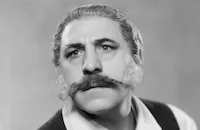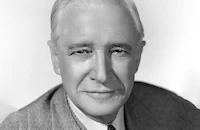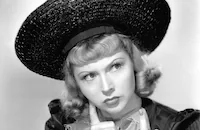Top of the Town
Cast & Crew
Ralph Murphy
Doris Nolan
George Murphy
Ella Logan
Hugh Herbert
Gerald Oliver Smith
Film Details
Technical Specs

Synopsis
Since her trip to Russia, Diana Borden is determined to introduce art to nightclubs and the perfect opportunity presents itself when bandleader Ted Lane hires her as a chorus girl. There is only one catch: he hired her because she is the niece of the four Borden brothers, owners of the Moonbeam Room, a new club at the top of their building. Ted thinks that she will put in a good word for him, but the Bordens are horrified by her new career. Now, Ted has to get rid of her without making her so angry that she will speak against him. To make things worse, Diana is a real trouper and Ted falls in love with her. Finally, he decides that honesty is the best policy and tells her the situation. Believing that his career is more important than hers, she agrees to quit, but when she accidentally finds out that he had been trying to trick her into quitting she is convinced that he does not really love her. Ted does get hired to work at the Moonbeam Room, but what he does not know is that Diana has persuaded her uncles to put her in charge. Stubbornly, she puts on an "artistic" show with a recital of Hamlet and a number set in a Russian salt mine. To her dismay, the audience starts to walk out until Ted takes over. He plays a lively number, his performers get the whole room dancing, and the club is a big success. Diana is crushed, but she recovers quickly when Ted lovingly comforts her.

Cast
Doris Nolan

George Murphy
Ella Logan

Hugh Herbert
Gerald Oliver Smith

Mischa Auer

Gregory Ratoff

Peggy Ryan
Jack Smart
Ray Mayer

Henry Armetta
The Three Sailors

Gertrude Neisen
The Original California Collegians
The Four Esquires

Claude Gillingwater

Ernest Cossart

Samuel S. Hinds

Richard Carle

Joyce Compton
Verna Leslie
Ethelreda Leopold
Frances Grant
Willie Fung
Billy Wayne
Sean Mor
Alexander Melesh
Harry Depp
Jack Chefe
Leonid Snegoff
Tom Herbert
Milton Shockley

Bud Flannigan
Lee Tong Foo
Bert Jason
Walter Byron
Harry Blue
Bob Robson
David Oliver
Crew
Harold Adamson
B. Ashley
Robert Benchley
Lou Brock
Lou Brock
Bernard [b.] Brown
Edward Eliscu
John P. Fulton
Amy Gaunt
Charles Gould
Charles Grayson
John Harkrider
John Harkrider
William Hedgecock
Charles Henderson
L. Henry
Ross Hoffman
Brown Holmes
H. Johnson
Phil Karlstein
Jimmy Mchugh
Hal Mohr
Albert Nickels
Charles Previn
Charles R. Rogers
Morrie Ryskind
James Seymour
Frank Skinner
Jack Martin Smith
Charles Stallings
Robert Surtees
Gene Synder
Joseph Valentine
B. Weiler
Sam White
Sam White
Maurice E. Wright

Film Details
Technical Specs

Articles
Peggy Ryan (1924-2004)
Born Margaret O'Rene Ryan on August 28, 1924, in Long Beach, California, Ryan began dancing professionally as a toddler in her parents' vaudeville act, the Dancing Ryans, and was discovered by George Murphy when she was 12. Murphy arranged for young Peggy to dance with him in the Universal musical Top of the Town (1937). She would go on to make a few more film appearances over the next few years - the most striking of which as a starving, homeless girl in John Ford's The Grapes of Wrath (1940) - yet for the most part, she was hardly noticeable apart from a few dance numbers.
Her luck changed when Universal cast her opposite another teenage hoofer, Donald O'Connor in What's Cookin'? (1942). From then on, they teamed in a series of innocuous musicals that were low on production values, but high on youthful pluck. Just check out some of their titles: Private Buckaroo, Give Out, Sisters!, Get Hep to Love (all 1942); Top Man, Mr. Big (both 1943); Chip Off the Old Block, This Is the Life, and Bowery to Broadway (all 1944). They may have not been high art, but jitterbuggin' kids loved it, and given the low investment Universal put into these pictures, they turned quite the profit.
Her career slowed down after the war. In 1945, she married songwriter James Cross, and didn't return to films until 1949, when she made two minor musicals that year: Shamrock Hill, There's a Girl in My Heart. She divorced Cross in 1952 and met her second husband, dancer Ray McDonald, in her final film appearance, a forgettable musical with Mickey Rooney, All Ashore (1953). Tragically, McDonald died in 1957 after a food choking incident, and the following year, Ryan moved to Honolulu after marrying her third husband, Honolulu Advertiser columnist Eddie Sherman. She kept herself busy teaching dance classes at the University of Hawaii, but in 1969, she found herself back in front of the camera as Jenny Sherman, secretary to Detective Steve McGarrett (Jack Lord) on the long-running show Hawaii Five-O,. She played the role for seven years, remaining until 1976.
Eventually, Ryan relocated with her husband to Las Vegas, where for the last few years, she was teaching tap dancing to a whole new generation of hoofers. She is survived by her son, Shawn; daughter Kerry; and five grandchildren.
by Michael T. Toole

Peggy Ryan (1924-2004)
Quotes
Trivia
Notes
A production article in Motion Picture Herald credits both Robert Benchley and Lou Brock with the original story, although only Brock is credited onscreen. It notes further that the set of the Moonbeam Room was 70 ft. high, covered 40,500 sq. ft. and accomodated 1,000 people in the final nightclub sequence.
Top of the Town marked the feature-film debut of Peggy Ryan (1924-2004). The actress-dancer was best known for her co-starring roles with Donald O'Connor in a series of Universal teenage musicals produced in the 1940s, including The Merry Monahans. Top of the Town also marked the first time that an art director was credited onscreen as "Production Designer." Noted art director John Harkrider (1899-1982) was also a costume designer and co-directed the 1929 Paramount Famous Lasky production Glorifying the American Girl (see AFI Catalog of Feature Films, 1921-30).















